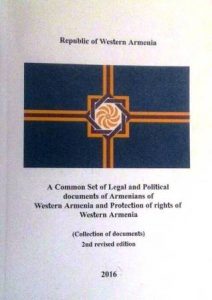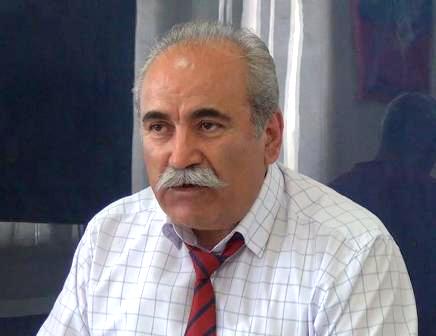27.04.2017 – Declaration in the memory of martyrs of the genocide perpetrated against the Armenian people during 1894-1923
 Taking into consideration that
Taking into consideration that
a) The present international political order, which reigned after 2nd world war, is in impasse now. The formation of a new international political order became an urgent requirement for some influential powers who seek peace and stability of the globe. This should be based on the prevalence of international law, mutual intergovernmental respect and principles of equal rights of nations.
b) The political and military developments happening during the last two decades within the vital territory of Near East and especially territories populated by Armenians and other ethnic and religious components, where they all exist and shall continue to exist. Those developments, day after day, expose Armenians and other people to serious human, national and cultural threats, without essential self-defense chances.
c) The occupied territories including the seven provinces of Western Armenia and Cilicia, nowadays are the place of recruitment, preparation, training and deployment for terroristic groups who commit the21st century’s most barbaric and cruel crimes against humanity, under the surveillance of the same bloodthirsty and barbarous criminals, who have committed the same crimes a century ago through genocide and forcible deportation of the Armenian and other indigenous nations.
Taking into consideration as well that
d) All the international documents recognizing the independence and statehood of Western Armenia, especially:
- The Declaration of France about the independence of Cilicia;
- Decree of Russia about the independence of Western (Turkish) Armenia;
- Decisions of Versailles and San Remo conferences about the international (De-facto and De-jure) recognitions of the Armenian state;
- The Peace Treaty of Sèvres, and Arbitral Award of USA president W. Wilson about the borders between Western Armenia and Turkey;
- Declaration of UNO about the human rights;
- Declaration of UNO about the rights of indigenous peoples.
e) All the declarations and decisions referring to foundation of the National Council of Western Armenia, creation of the State institutions, defense of the rights of people of Western Armenia, as well as the Constitution of the Republic of Western Armenia.
The Republic of Western Armenia declares and confirmes the below stated principles.
1. The territories including the 7 provinces of Western Armenia and Cilicia are under forcible occupation by Turkey and are subject to liberation through means of the international law.
2. The Republic of Western Armenia, through all the possibilities and obligations given by sovereignty, will put into action all the means of the international law, for the total liberation of all above mentioned occupied territories of Western Armenia and Cilicia.
3. The state institutions of Western Armenia are ready to undertake all the territorial and statehood responsibilities before both, the International society and the people of Western Armenian, including all the other ethnic and religious communities and minorities living within its territories.
This Declaration shall be passed to the awareness of worldwide spread Armenian people, and those living in occupied Western Armenia and Cilicia including the different ethnic and religious communities and minorities, as well as to the awareness of the international society, to be regarded as the decisive base for our upcoming steps and political activities.
Government of the Republic of Western Armenia
The official delegation of the Republic of Western Armenia, headed by the Prime Minister of the Republic Tigran Pashabezyan, honored the memory of the Holy Martyrs – victims the Genocide of the Armenians
 The official delegation of the Republic of Western Armenia, headed by the Prime Minister of the Republic Tigran Pashabezyan, honored the memory of the Holy Martyrs – victims the Genocide of the Armenians.
The official delegation of the Republic of Western Armenia, headed by the Prime Minister of the Republic Tigran Pashabezyan, honored the memory of the Holy Martyrs – victims the Genocide of the Armenians.
On April 24, 2017, members of the Government, Deputies of the National Assembly (Parliament) and citizens of Western Armenia laid flowers to the eternal fire of the Tsitsernakaberb Memorial Complex in Yerevan.
(Photoreport)






Photoreport – April 24, 2017. The deputies of the Parliament of Western Armenia together with the citizens of the Republic of Western Armenia took part in mourning events dedicated to the memory of the victims of the Genocide of the Armenians in Western Armenia, Cilicia and the Ottoman Empire in 1894-1923

April 24, 2017. The deputies of the National Assembly (Parliament) of Western Armenia, along with the citizens of the Republic of Western Armenia, took part in mourning events in Russia (Moscow, Rostov-on-Don, Sochi, Volgograd, Crimea), in France (Paris, Marseille and Lion), Abkhazia (Sukhum and Gagra), the USA (Los Angeles and Glendel), Syria, Sweden, Germany, Armenia and other cities of the world dedicated to the memory of the victims of the Genocide of the Armenians in Western Armenia, Cilicia and the Ottoman Empire in 1894-1923 years.
(Photoreport)
Abkhazia (Gagra, Sukhum)




France, Lyon



USA, Los Angeles





Russia, Moscow



Russia, Sochi




Armenia, Yerevan






«About the strategy of the State of Western Armenia on the Genocide of the Armenians recognition, condemnation and compensation issues»
 Announcement of the National Assembly (Parliament) of Western Armenia
Announcement of the National Assembly (Parliament) of Western Armenia
Western Armenia’s strategy on the Genocide of the Armenians recognition, condemnation and compensation issues is built on the exact answers on the following questions:
– The Genocide of the Armenians was condemned in 1896, 1909, 1915, 1919. How the Genocide of the Armenians recognition and condemnation issues arose again?
– When the Genocide of the Armenians was carried out, which years, by whom and what is the chronology of the Genocide of the Armenians, 1915-1923 or 1894-1923.
– What is the damage to Armenians and Armenia caused by the genocide, whether that damage was assessed, are there any calculations, in other words, is there a complete package for the calculation of compensation for damage.
- The Genocide of the Armenians was carried out in 1894-1923, during three successive Turkish governments: Sultans, Young Turks and Kemalist.
The Genocide of the Armenians was condemned in 1896, 1909, 1915, 1919 years:
1894-96 period: Sultan Abdul Hamid II organized the massacres and killed nearly 300 thousands of Armenians, 200 thousands were forced to religious conversion, 100 thousand Armenians were deported. The massacre of Armenians was carried out by the Turkish regular army, “the Turk” regiments, police and the Muslim mob.
Turkish policy of forced religious conversion during Hamid massacres of Armenians became the basis for starting the policy of islamization and continuation a more brutal manner.
1894-96 period: Hamid massacres and killings had been condemned by the leading figures of that time Jean Jaurиs, Victor Berare, Anatole France, Johannes Lepsius, Lynch and others.
1909 year: Adana massacres handwriting was the same, as the Turkish government organized, carried out by a nationalist mob, and the Turkish army took part in. Nearly 30 thousand people were killed during Adana massacres. The Young Turks organized a trial related to the fact of genocide, but it was a mere formality. Moreover, through the artificially administered fire they tried to destroy the documents, related to that trial, but even though many items were saved and preserved to these days.
1915 year: On May 24th, the governments of England, France and Russia came up with special joint declaration, where three large countries publicly characterize the Turkish actions against Armenians as crimes against “humanity and civilization” for which “personal responsibility is laid on every member of the Turkish government who participated in the carnages”.
The text particularly says: For about a month the Kurd and Turkish populations of Armenia has been massacring Armenians with the connivance and often assistance of Ottoman authorities. Such massacres took place in middle April (new style) at Erzerum, Dertchun, Eguine, Akn, Bitlis, Mush, Sassun, Zeitun, and throughout Cilicia. Inhabitants of about one hundred villages near Van were all murdered. In that city Armenian quarter is besieged by Kurds. At the same time in Constantinople Ottoman Government ill-treats inoffensive Armenian population. In view of those new crimes of Turkey against humanity and civilization, the Allied governments announce publicly to the Sublime-Porte that they will hold personally responsible [for] these crimes all members of the Ottoman government and those of their agents who are implicated in such massacres”.
1919 year: Constantinople’s military court the trial of Ottoman Turkey ruling elite took place with the following accusations of Young Turk leaders for: a) Involvement of the Ottoman Empire in the First World War, b) Organization and implementation of Armenian’s of the Ottoman Empire comprehensive homicide and deportations. The court sentenced in absentia to death many of the Young Turk leaders, including Talaat, Enver, Jemal and Nazim, Kemal Bey, Cemal Azmin and Naim Bey, Behaeddin Shakir, which in future was implemented by Nemesis Armenian avengers.
In 1919 the assessment of the damage to Western Armenia was carried out.
In 1920 The Treaty of Sиvres was signed, which 88-93 refers to The State of Armenia and on November 22, 1920 28th U.S. President Woodrow Wilson’s Department of State released an Arbitral Award related to Turkish and Armenian borders.
These facts indicate that using the provisions of the Sevres Treaty and Wilson’s Arbitral Award the compensation for damage of the genocide of Armenians and Armenia, as well as the caused material damage compensation had been decided, signed, ratified, however, had never been realized.
Moreover, after 1923 everything was deliberately forgotten.
2. The Genocide of the Armenians condemnation time
As already mentioned, the international community after The Lausanne Conference, in the period of 1923-1965, skillfully skirted the issue of the Genocide of the Armenians and fall into oblivion.
It was possible to demolish the wall of oblivion in 1965 by the movement, claiming demonstrations, devoted to the 50th anniversary of the Genocide and, especially, in 1973-1975 by the national liberation struggle developed overseas, with great effort and sacrifice of Gurgen Yanikian, Gevorg Achemyan, Simon Simonyan, Armenian Secret Army for the Liberation of Armenia, the Genocide of the Armenians Justice Commandos and other organizations and individuals.
1965-1985 years were the years of the Genocide of the Armenians recognition. It was the time when in parallel with the development of the liberation struggle of Armenians, the world media was literally flooded by voluminous reports, interviews, articles, books, TV and movies about the Genocide of the Armenians and Armenia.
1985 and 1987 were the years of Gorbachev perestroika and adoption by the European Parliament the resolution for “a political solution to the Armenian question”, which were immediately followed by the Armenians massacres in Sumgait, Baku, Ganja and other regions, deportation and the aggression against Nagorno-Karabakh and Armenia by the Republic of Azerbaijan.
The new era of national liberation struggle’s second phase started during the war in Artsakh in 1988-1994, after the victory of which would really come the time for the condemnation and compensation of the Genocide of the Armenians, especially since, as a nation, we could resist the attempt for a new genocide of the Armenians.
Although precious time has been lost, but all is not lost.
You just have to accept that the Genocide of the Armenians recognition forced process is completed and you have to make the transition to international condemnation and compensation process of the Genocide of the Armenians.
3. The issue of the Genocide of the Armenians chronology: 1915-1923 or 1894-1923?
On this issue, from the legal position perspective, it is important to know at what time and by whom the Genocide of the Armenians was carried out. In that sense, the 1915-1923 period formulation can be rejected. The 1894-1923 period formulation and chronology is true and historically grounded, because three or more successive Turkish governments, the Ottoman, Young Turk, Kemal, carried out similar acts of extermination towards Armenians. To compare we can look at the National Council of Western Armenia’s request dated on April 24, 2011 to the Turkish President Abdullah Gul.
It is for sure worth mentioning Hamidian massacres during the 1894-96 period, organized by Sultan Abdul Hamid 2nd, the Young Turks’ massacre of Armenians in Adana in 1909, which are also episodes of the Genocide of the Armenians. We have no any legal, political, or moral right to ignore and fall into oblivion them, especially since they are very important steps and have a meaningful role in the whole chain for the future of Armenians’ claim.
4. A complete set of compensation for damage caused by the Genocide of the Armenians:
In order to make the idea of a complete set of compensation for damage caused by the Genocide of the Armenians, it is important to just remember all the crimes perpetrated by three successive Turkish governments (Sultans, Young Turks, Kemals) against humanity and Armenians.
Simply let us list them:
– National superiority and arrogance, racism, formation of Pan-Turkism, its dissemination and advocacy in Turkish environment.
– Development, dissemination and propaganda of the plans and ideas to exile Armenians and carry out the genocide of Armenians.
– During 1894-23 period in the Armenian Highland, on the Ottoman Empire’s territory, the planning, advocacy, preparation, proviking and carrying out the genocide of Armenians, embezzlement and plunder of their property. Destruction of more than two millions of Armenians, over half a million deportations from their cradle of homeland.
– In 1915 and in subsequent years implementation of the massacres and genocide, theft and misappropriation of their property together with Armenians also Assyrians, Greeks, Arabs (later since the mid of 1920s Kurds as well).
– In 1918 aggression towards the Armenians of Western Armenia, forcing the newly imposed Republic of Armenia to sign illegal contract.
– In 1918 carrying out the genocide of Armenians in Baku
– In 1920 the aggression against the Republic of Armenia, later with forcing to sign illegal and illegitimate treaties (1920, in Alexandropol and 1921 in Moscow) to the party subjected to aggression.
– In 1937 carrying out the genocide and killings of Armenians in Dersim.
– 1894-1923, 1923-2014 period: destroying Armenian civilizational values, including the historical and architectural monuments and churches.
– Falsification of history, culture and civilization values of Armenians and other nations in the region.
– Denial of the historical fact and reality of the Genocide of the Armenians, with unrealistic expectations to gain the time and postpone the suggestion to create of a commission of historians.
– 97-year occupation of the territory allotted by Wilson’s Arbitral Award, dated November 22, 1920
– Illegal blockade of Armenia since 1993.
This is not a complete list of all the crimes perpetrated by the Turkish successor governments against humanity and Armenians. The crimes committed by Azerbaijan is the copied version of the program, planned by Turkey. However, we’ll talk about them in other occasion, in another place.
To add to all this, till now the amount of damage to Eastern Armenia was not compensated, as well as the damage caused in 1923 and following years to the Armenian people and Armenia. But the crimes listed here, are direct evidence of the harm that can and should be calculated, thus to prepare the complete compensation package for the actual amount of damage caused to Armenians and Armenia.
As the final word, one important note as well. We can state that the Genocide of Armenians continues till now and will continue until the crime conviction and the full compensation for harm caused. And as long as the Armenians are not able to regain the power to live, develop and progress under the legal, political, national, state firm and unshakeable basis.
Armen Ter-Sarkisyan
President of National Assembly (Parliament) of Western Armenia
Turkey: UN report details allegations of serious rights violations in country’s southeast
 The UN human rights office today published a report detailing allegations of massive destruction, killings and numerous other serious human rights violations committed between July 2015 and December 2016 in southeast Turkey.
The UN human rights office today published a report detailing allegations of massive destruction, killings and numerous other serious human rights violations committed between July 2015 and December 2016 in southeast Turkey.
“I am particularly concerned by reports that no credible investigation has been conducted into hundreds of alleged unlawful killings, including women and children over a period of 13 months between late July 2015 and the end of August of 2016,” UN High Commissioner for Human Rights Zeid Ra’ad Al Hussein said in a news release published by his Office (OHCHR).
“It appears that not a single suspect was apprehended and not a single individual was prosecuted,” he added.
During that period, Government security operations affected more than 30 towns and neighbourhoods and displaced between 335,000 and half a million people, mostly of Kurdish origin.
Mr. Zeid acknowledged the complex challenges Turkey has faced in addressing the attempted coup of July 2016 and in responding to a series of terror attacks. However, he said the apparent significant deterioration of the human rights situation in the country is cause for alarm and would only serve to deepen tensions and foster instability.
The news release said that measures taken under the state of emergency following the attempted coup of July 2016, including the dismissal of more than 100,000 people from public or private sector jobs during the reporting period, have also deeply affected the human rights situation in the southeast.
Some 10,000 teachers were reportedly dismissed on suspicion of having links with the Kurdistan Workers Party (PKK), which the Government considers a terrorist organization, without due process.
The use of counter-terrorism legislation to remove democratically elected officials of Kurdish origin, the severe harassment of independent journalists, the closure of independent and Kurdish language media and citizen’s associations and the mass suspension of judges and prosecutors have also severely weakened checks and balances and human rights protections.
“The Government of Turkey has failed to grant us access, but has contested the veracity of the very serious allegations made in this report. But the gravity of the allegations, the scale of the destruction and the displacement of more than 355,000 people mean that an independent investigation is both urgent and essential,” Mr. Zeid said.
Office of the United Nations High Commissioner for Human Rights
Report on the human rights situation in South-East Turkey
July 2015 to December 2016
March 11, 2017 in Yerevan will host the second international conference: ”Hetero-dox Armenians in the modern world”
 The conference, organized by the representatives of the permanent commissions of the National Assembly (Parliament) of Western Armenia on issues of land, patriotic and community organizations and on issues of religion and spiritual life, will be held on Saturday, March 11, 2017, at 18:00 in Yerevan, Congress “at the address: the avenue of Italy 1.
The conference, organized by the representatives of the permanent commissions of the National Assembly (Parliament) of Western Armenia on issues of land, patriotic and community organizations and on issues of religion and spiritual life, will be held on Saturday, March 11, 2017, at 18:00 in Yerevan, Congress “at the address: the avenue of Italy 1.
The beginning of the work (registration of participants) of a private meeting in the format of a round table – at 17:30
Themes of the round table:
Preparation of the basis for implementation and implementation of the decisions taken by the participants of the previous conference, held on September 8, 2016.
Namely :
1. Collection of data and information on non-Orthodox Armenians residing in the Near and Middle East, creation of a data collection center on this topic.
2. Development of strategic-working programs to establish links with other Armenians living in Western Armenia (including the Middle and Near East).
3. Assistance to those Armenians who wish to return to their roots and express their readiness to return to their native homeland.
Armenak Armandanyan
Representative of the Standing Committees of the National Assembly of Western Armenia (Parliament) on Religion and the Issues of the Country
February 5, 2017
Western Armenia to not Participate in ConIFA World Football Cup for No Security Guarantees
 The Western Armenian team will not participate in the 2017 Confederation of Independent Football Associations (ConIFA) World Football Cup because of lack of security guarantees, ConIFA Vice-President Dimitri Pagava told reporters after the Annual General Meeting in Geneva, TASS reports.
The Western Armenian team will not participate in the 2017 Confederation of Independent Football Associations (ConIFA) World Football Cup because of lack of security guarantees, ConIFA Vice-President Dimitri Pagava told reporters after the Annual General Meeting in Geneva, TASS reports.
The 2017 European Football Cup will be held from June 4-11 in Northern Cyprus, and the Turkish side has failed to provide security guarantees to the Armenian club.
This year the title will be contested by Northern Cyprus, Padania, Sapmi (Lapland), Abkhazia, County of Nice, Székely Land, Occitania and Ellan Vannin (Isle of Man).
ConIFA, the Confederation of Independent Football Associations, is the football federation for all associations outside FIFA. Western Armenia and Nagorno Karabakh are members of the Confederation.
ConIFA is a global acting non-profit organization that supports representatives of international football teams from nations, de-facto nations, regions, minority peoples and sports isolated territories.
ConIFA was founded in June 2013, and organized its first World Football Cup in June 2014 in Ostersund, Sweden.
A Common Set of Legal and Political documents of Armenians of Western Armenia and Protection of rights of Western Armenia.
 A Common Set of Legal and Political documents of Armenians of Western Armenia and Protection of rights of Western Armenia
A Common Set of Legal and Political documents of Armenians of Western Armenia and Protection of rights of Western Armenia
This edition presents the final settlement of the Armenian Question, the protection of rights of Armenians in Western Armenia, as well as the key set of core section on legal and political documents for protection of Armenians rights towards Armenia, which forms part of the declarations and decrees, resolutions and statements.
The 2nd revised edition consists of new important documents, which are included in all 4 CHAPTERs of this edition. Continue reading

 A Common Set of Legal and Political documents of Armenians of Western Armenia and Protection of rights of Western Armenia
A Common Set of Legal and Political documents of Armenians of Western Armenia and Protection of rights of Western Armenia





